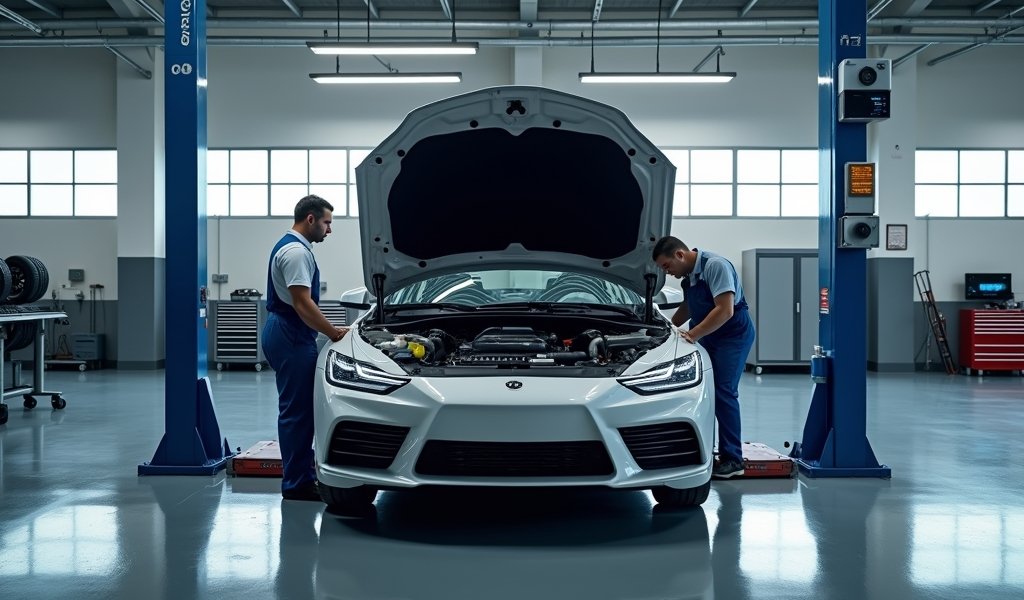Overview
This article provides seven essential tips for maintaining a new vehicle, including following manufacturer service schedules, getting timely break-in service, creating a personalized maintenance calendar, understanding regular versus severe service needs, choosing the right service provider, performing seasonal maintenance, and handling basic DIY upkeep between professional services. Proper vehicle maintenance is presented as an investment strategy that extends vehicle life, preserves value, and prevents costly repairs while ensuring warranty protection.
Table of Contents
- Understanding Manufacturer’s Recommended Service Schedule
- The Importance of Break-In Service
- Creating a Personalized Maintenance Calendar
- Regular vs. Severe Service Schedules: Know the Difference
- Choosing the Right Service Provider
- Don’t Overlook Seasonal Maintenance
- Basic DIY Maintenance Between Services
- Conclusion
- Frequently Asked Questions
Getting behind the wheel of a new car is one of life’s simple pleasures. That new car smell, the pristine interior, and the peace of mind knowing everything is working perfectly. But keeping it that way? That requires a solid new car service schedule. After 15 years working as a master technician, I’ve seen firsthand how proper maintenance can extend a vehicle’s life by years—and how neglect can cut it tragically short.
Your new vehicle is more than transportation; it’s an investment. And like any investment, it requires careful attention to maintain its value. Whether you’re driving a family SUV, a sleek sedan, or a rugged pickup, following these seven proven tips will help ensure your vehicle stays reliable for years to come.
Understanding Manufacturer’s Recommended Service Schedule
Your vehicle’s manufacturer didn’t just throw together a random maintenance schedule. They engineered your car from the ground up and know exactly what it needs to perform optimally. This schedule is your vehicle’s roadmap to longevity.
You’ll find this critical information in your owner’s manual (usually in a dedicated maintenance section), on the manufacturer’s website, or through the dealership. Many modern vehicles even have maintenance reminder systems that calculate service intervals based on your actual driving habits rather than simple mileage.
Following these guidelines isn’t just good practice—it’s often required to maintain your warranty. Most new vehicles have similar initial service intervals, typically recommending an oil change every 5,000-7,500 miles, though this varies by make and model.
The latest research on oil change intervals suggests that modern synthetic oils can often go longer between changes than conventional wisdom once dictated. However, it’s always best to defer to what your specific vehicle manufacturer recommends.
The Importance of Break-In Service

One of the most overlooked yet critical services for a new vehicle is the break-in service. This typically occurs around 500-1,000 miles and serves as the foundation for your vehicle’s long-term performance.
During the first few hundred miles, your engine’s components are still “getting acquainted” with each other. Metal parts are settling into place, and during this process, tiny metal particles naturally shed into your oil. The break-in service removes these particles before they can cause damage.
A proper break-in service typically includes:
- Oil and filter change
- Inspection of all fluid levels
- Verification of tire pressures
- Check of all belts and hoses
- Verification that everything is functioning as intended
I’ve seen engines last well beyond 200,000 miles when this critical first service was performed on time—and others develop issues before 100,000 miles when it was skipped. Your vehicle deserves this important foundation for long-term reliability.
Creating a Personalized Maintenance Calendar
Manufacturer guidelines provide the framework, but creating your own personalized maintenance calendar ensures you’ll never miss an important service. Think of it as a healthcare plan for your vehicle.
Effective tracking methods include:
- Digital maintenance apps like CARFAX Car Care or MyCarfax
- Calendar reminders on your smartphone
- Service reminder stickers (or their digital equivalent in your dashboard)
- A simple maintenance logbook kept in your glove compartment
When creating your calendar, consider your specific driving habits. Do you make lots of short trips? Drive in extreme temperatures? These factors might mean you need more frequent service than the standard intervals suggest.
I recommend setting reminders about 500 miles before each service is due. This gives you plenty of time to schedule an appointment without feeling rushed. A comprehensive car maintenance schedule by mileage will help you anticipate upcoming needs and budget accordingly.
Regular vs. Severe Service Schedules: Know the Difference
Here’s a secret that dealers don’t always emphasize: most owner’s manuals outline two different maintenance schedules—”normal” and “severe.” And surprisingly, many of us fall into the “severe” category without even realizing it.
Severe driving conditions include:
- Frequent short trips (less than 10 miles)
- Stop-and-go traffic
- Extreme temperatures (hot or cold)
- Dusty, muddy, or salt-treated roads
- Towing or carrying heavy loads
- Mountainous terrain
Sound familiar? If you commute in urban areas or experience seasonal weather extremes, you’re likely in the “severe” category. This typically means more frequent oil changes (every 3,000-5,000 miles rather than 7,500) and more attention to components like brakes and transmission fluid.
I’ve repaired too many vehicles that failed prematurely because their owners followed the “normal” schedule when their driving habits clearly called for the “severe” one. When in doubt, choose the more conservative service interval—your vehicle will thank you with years of reliable service.
Choosing the Right Service Provider

Where you service your vehicle matters almost as much as when you service it. You generally have three options:
Dealership Service Centers: These offer specialized knowledge of your specific make and model, factory-trained technicians, and original equipment parts. They also maintain digital service records linked to your VIN, which can boost resale value. The downside? They’re typically the most expensive option.
Independent Shops: Often more affordable than dealerships, these shops can provide more personalized service and usually handle most maintenance tasks effectively. Look for ASE-certified technicians and shops with good reputations in your community.
Mobile Service Providers: Companies like ours (Knows Your Car in Charlotte, NC) bring the service to you, eliminating wait times and the hassle of traveling to a shop. We specialize in conveniences like mobile oil changes, tire replacement, brake repairs, and diagnostic services that come to your home or workplace.
Regardless of which type you choose, look for clear communication, detailed invoices, and technicians who take the time to explain what they’re doing and why. A good service provider should feel like a partner in your vehicle’s care, not just a transaction.
Most importantly, ensure they follow manufacturer guidelines to maintain your warranty validity. According to the Federal Trade Commission, you don’t have to use the dealer for service to maintain your warranty—but you do need to follow the manufacturer’s maintenance requirements.
Don’t Overlook Seasonal Maintenance
Your vehicle faces different challenges throughout the year, and adjusting your maintenance schedule seasonally can prevent problems before they start. Think of these as your vehicle’s spring cleaning and winter preparations.
Spring/Summer Preparation:
- Check air conditioning performance before the heat arrives
- Replace cabin air filters (especially important for allergy sufferers)
- Inspect cooling system components and coolant level
- Check tire pressure as temperatures rise (pressure increases in hot weather)
- Test your battery (contrary to popular belief, heat is actually harder on batteries than cold)
Fall/Winter Preparation:
- Test your heating system before the first cold snap
- Check battery strength and connections
- Inspect wiper blades and washer fluid (use winter-grade fluid in cold climates)
- Consider winter tires for snow regions
- Verify proper antifreeze concentration
Here in Charlotte, NC, our humid summers can be particularly hard on cooling systems, while our occasional winter ice storms demand good wipers and properly functioning defrosters. Regional considerations should always factor into your maintenance planning.
I recommend scheduling these seasonal check-ups about a month before extreme weather typically arrives. This gives you time to address any issues before they become problems in challenging conditions.
Basic DIY Maintenance Between Services
Professional service is essential, but there’s plenty you can do between appointments to keep your vehicle in top shape. These simple checks take just minutes but can catch small issues before they become expensive problems.
Monthly DIY checks should include:
- Tire pressure (including the spare)
- All fluid levels (oil, coolant, brake fluid, washer fluid)
- Wiper blade condition
- All lights and signals
- Quick under-vehicle inspection for fluid leaks
Warning signs that warrant immediate professional attention include dashboard warning lights, unusual noises (especially when braking or turning), fluid puddles under the vehicle, vibrations, or reduced performance. Don’t ignore these signals—they rarely resolve themselves and typically worsen over time.
For those interested in learning more, there are excellent resources available that provide step-by-step guidance for complete car service checks you can perform at home. Just remember that while DIY maintenance can save money and help you understand your vehicle better, complex tasks are best left to professionals.
I’ve seen too many well-intentioned DIY projects lead to expensive repairs. When in doubt, consult a professional—it’s almost always cheaper than fixing a mistake.
Conclusion
A new car is a significant investment, and like any investment, it requires attention and care to maintain its value. Following these seven proven tips for your new car service schedule will help ensure your vehicle provides years of reliable transportation and retains more of its value when it’s time to sell or trade.
Remember that consistency is key. Even the most advanced vehicles need regular attention, and small maintenance costs now can prevent major repair bills later. Think of it as preventive healthcare for your car—regular checkups keep small issues from becoming serious conditions.
If you’re in the Charlotte area and value the convenience of service that comes to you, consider scheduling your next maintenance visit with Knows Your Car through our website (knowsyourcar.com). Our mobile technicians bring expertise directly to your driveway, making vehicle maintenance more convenient than ever.
Your car takes care of you every day. With these tips, you can return the favor and enjoy many years of trouble-free driving.
Frequently Asked Questions
How often should I change the oil in my new car?
Most new vehicles recommend oil changes every 5,000-7,500 miles with synthetic oil. Always check your owner’s manual for the manufacturer’s specific recommendations for your model.
Can I skip the break-in service for my new car?
Skipping your break-in service is strongly discouraged as it removes metal particles that naturally occur as new engine components settle. This first service around 500-1,000 miles sets the foundation for your engine’s longevity.
Will performing my own basic maintenance void my warranty?
Basic maintenance like checking fluid levels will not void your warranty. However, for warranty-covered services, ensure you keep receipts for any parts and document the maintenance performed.
How do I know if I should follow the “severe” or “normal” service schedule?
If you frequently make short trips, drive in stop-and-go traffic, experience extreme temperatures, or drive on dusty/salty roads, follow the severe schedule. When in doubt, the severe schedule provides better protection for your vehicle.
Is the dealership service center always the best option for maintenance?
Dealerships offer specialized knowledge but aren’t always necessary for routine maintenance. Independent shops with ASE-certified technicians or mobile service providers can provide quality service, often at lower costs while maintaining your warranty.


Pingback: New Car Service Schedule: 5 Proven Fixes - knowsyourcar.com